
Students learn about vectors. There are a series of practice problems at the end of the lesson.
- Subject:
- Physics
- Science
- Material Type:
- Lesson Plan
- Provider:
- Science Education Gateway
- Author:
- Science Education Gateway
- Date Added:
- 02/26/2019

Students learn about vectors. There are a series of practice problems at the end of the lesson.

In this simulation activity, students will examine natural selection in a small population of wild rabbits.
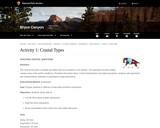
In this lesson, students experiment with representative materials to understand crustal interactions. By the end of the lesson, students will be able to list and draw the three types of plate interactions and name one landform that results from each plate interaction.

This hands-on activity allows students to re-acquaint themselves with magnets, magnetic fields and the concept of polarity.

In this activity, students will work in collaborative groups to develop an advertisement for a political candidate in support of one side of an issue - should we build low-cost housing on part of the land presently occupied by an estuary? Each group will decide which side they want to support - either for or against building the housing - and write an ad that will be run in a local paper, or that will be viewed on local TV, to support their argument.

In this lesson, students observe demonstrations and participate in hands-on activities that involve static electricity. Connections to everyday examples of static electricity and assessment ideas are included. Extension activities integrate Language Arts and family.

In this lesson, students explore how convection currents cause crustal plate movement.

In this lesson, students determine the particle size and composition of a sample of soil. Soil composition determines many characteristics of soils, such as infiltration rates (the rate at which water moves into a soil), percolation rates (how fast water moves through the soil), settling rates (how fast sediments sink to the bottom of a body of water), oxygen content, and the ability of the soil to support plant and animal life.

In this hands-on activity students create a simple electromagnet with wire, a pencil, and a battery. Students will investigate factors that increase the strength of the magnet.
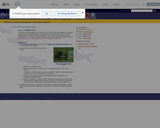
In this simulation activity, students will collect data, formulate a hypothesis, and run a series of experiments in order to discover the interplay between natural selection and sexual selection in a wild population of guppies.

In this lesson, students complete water quality tests such as pH, dissolved oxygen, nitrates, phosphates, and salinity for a water sample. After following these activities, students should understand the purpose of these tests, know how to run accurate water quality tests, and see how these parameters relate to the quality of the water in an estuary.
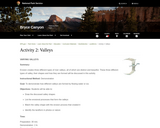
In this lesson, students demonstrate how different valleys are formed by flowing water or ice. Students list the erosional processes that form valleys and identify the landform in photos or in nature.

In this lesson, students identify which factors in an environment are biotic or abiotic factors and evaluate their effect on other organisms living within the environment.

In this lesson, students understand how water moves through different types of soils.
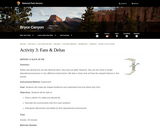
In this lesson, students create pie-shaped landforms and understand how and where they form. Students will distinguish between alluvial fans and deltas by their depositional environments.

In this hands-on activity, the generator effect will be demonstrated, due to electromagnetic induction when a conductor (extension cord) moves through a magnetic field (in this case, the Earth's magnetic field). Students will note changes in galvanometer readings.

In this activity, students decide which of their two favorite things they want to buy from their list in Activity 2. This activity is the companion to the Lesson 2: My Favorite Things. Activity is found on pages 14-17 of the pdf.
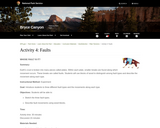
In this lesson, students use blocks of wood to distinguish among fault types and describe the movement along each type.

In this lesson, students explain how and why the settling rates of particles varies with particle size.
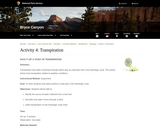
In this lesson, students investigate how plants perform a vital part in the hydrologic cycle.